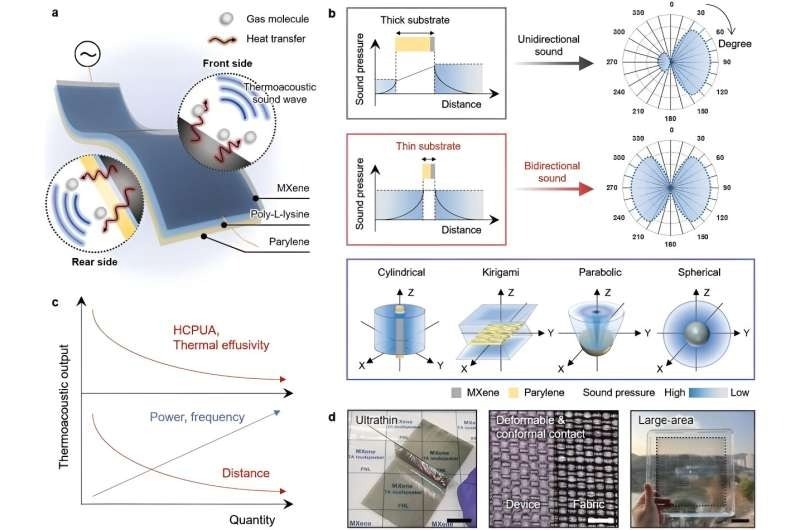A new study published in Advanced Materials details the creation of shape-configurable film-type speakers based on the unique features of MXene. These speakers provide variable sound directivity and show enormous potential for the rapidly emerging field of wearable electronics.
 A shape-configurable MXene-based TA loudspeaker with directivity-tunable sound generation. a) Schematic illustrating the working mechanism of the flexible MXene-based TA loudspeaker. b) Conceptual sound-pressure/distance plots and sound directivities of unidirectional thick (top) and bidirectional ultrathin substrates (middle), and schematics depicting 3D sound distributions of differently configured ultrathin TA loudspeakers (cylindrical, uniaxial kirigami, parabolic, and spherical) (bottom). c) Conceptual plots of intrinsic variables (HCPUA and thermal effusivity [top]) and extrinsic variables (input power and distance [bottom]). d) Photographs showing an MXene-based TA loudspeaker with an ultrathin (0.8-µm-thick) parylene substrate (left; scale bar, 2 cm); deformable and conformal contact with a fabric electrode having a line width of 150 µm (middle; scale bar, 500 µm); and a large-area (20 cm × 20 cm) specimen (right; scale bar, 5 cm). Image Credit: Advanced Materials (2023). DOI: 10.1002/adma.202306637
A shape-configurable MXene-based TA loudspeaker with directivity-tunable sound generation. a) Schematic illustrating the working mechanism of the flexible MXene-based TA loudspeaker. b) Conceptual sound-pressure/distance plots and sound directivities of unidirectional thick (top) and bidirectional ultrathin substrates (middle), and schematics depicting 3D sound distributions of differently configured ultrathin TA loudspeakers (cylindrical, uniaxial kirigami, parabolic, and spherical) (bottom). c) Conceptual plots of intrinsic variables (HCPUA and thermal effusivity [top]) and extrinsic variables (input power and distance [bottom]). d) Photographs showing an MXene-based TA loudspeaker with an ultrathin (0.8-µm-thick) parylene substrate (left; scale bar, 2 cm); deformable and conformal contact with a fabric electrode having a line width of 150 µm (middle; scale bar, 500 µm); and a large-area (20 cm × 20 cm) specimen (right; scale bar, 5 cm). Image Credit: Advanced Materials (2023). DOI: 10.1002/adma.202306637
Due to their massive vibrating diaphragms, traditional loudspeakers have challenges integrating with wearable devices. However, the team’s ultra-thin thermoacoustic (TA) loudspeakers, which are free of such constraints, show exceptional potential in this sector. Due to its low sound pressure level (SPL) during mechanical deformations and restricted conformability, these speakers are difficult to configure into any designs.
To overcome these obstacles, the study team concentrated on regulating the MXene conductor's heat capacity per unit area and the thermal effusivity of the substrates. Using this method, they were able to create an ultrathin MXene-based TA loudspeaker with a high SPL output of 74.5 dB at 15 kHz and steady sound performance over 14 days.
The ability to create bidirectional and deformation-independent sound in various bending, twisted, cylindrical, and stretched-kirigami forms utilizing the parylene substrate is a significant advance in this study. Using a parylene substrate with a thickness less than the thermal penetration depth allowed for creating speakers capable of emitting sound in different directions, independent of their form.
Furthermore, the researchers applied their inventiveness to developing parabolic and spherical variants of ultrathin, large-area (20 cm×20 cm) MXene-based TA loudspeakers. These speakers displayed sound-focusing and 3D omnidirectional sound-generation capabilities, bringing up new avenues for immersive audio experiences.
Professor Hyunhyub Ko and his research team from UNIST's School of Energy and Chemical Engineering spearheaded the project, working with Dr. Ki-Seok An’s group at the Korea Research Institute of Chemical Technology (KRICT) as collaborators.
Prominent Georgia Institute of Technology alumnus Dr. Jinyoung Kim, co-first author of the study, emphasized the remarkable performance of the MXene-based speakers. The higher performance of thermophonic speakers could be achieved by combining the two-dimensional conductive properties of MXene with the controlled thickness of parylene.
This study’s ultra-thin speaker fabrication method has the potential to be an essential part of technology for a range of wearables and sound control caused by shape deformation.
Professor Ko highlighted the broad range of possibilities for this thermal sound speaker technology:
The ability to customize device structure design and achieve shape-shifting and directional-adjustable speakers opens up possibilities for portable and home audio systems, active noise control, flexible active displays, and immersive entertainment systems.
Dr. Jinyoung Kim, Study Co-First Author and Postdoctoral Researcher, Georgia Institute of Technology
Journal Reference:
Kim, J., et al. (2023). Shape-Configurable MXene-Based Thermoacoustic Loudspeakers with Tunable Sound Directivity. Advanced Materials. doi:10.1002/adma.202306637.